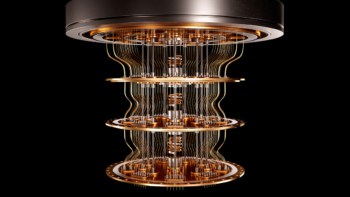Physicists in the US have shown that the Casimir force -- a mysterious quantum phenomenon that draws nearby mirrors together -- can exist in a fluid. The researchers found that two gold-plated surfaces submerged in ethanol experienced the attraction when brought within 200 nm of each other, albeit two times weaker than the force that would be found in a vacuum. This could, they say, lead to a new "quantum floatation" effect, which could be used to design better sensors (arxiv.org/abs/0705.3793v1).
First predicted by Hendrik Casimir in 1948, the Casmir force arises when two facing mirrors are brought towards each other in a vacuum. According to quantum mechanics, any electromagnetic fields bouncing back and forth between the mirrors should constantly fluctuate in strength. At very small mirror separations these fields exert a radiation pressure on the surfaces that is, on average, stronger on the outer than the inner surfaces. This causes an overall Casimir force that draws the surfaces together.
Now, Jeremy Munday and Federico Capasso of Harvard University in the US have shown that the Casmir force can still exist when the vacuum is replaced by a fluid. They attached a 40-µm-diameter polystyrene ball covered in a thin layer of gold to a cantilever, which they then suspended inside a bath of ethanol with a flat gold surface at the bottom. By reflecting a laser off the cantilever onto a position-sensitive photodetector, they could then determine the strength of the Casimir force attracting the ball from the size of its displacement.
They found that the force became detectable when the ball was brought within 200 nm of the flat surface, and when the separation was just 50 nm the force rose to 120 pN – about two times weaker than the force that would be found in a vacuum. This shows, according to Munday, that the ethanol screens the Casimir force by altering the allowed modes of the electromagnetic fluctuations between the surfaces.
Recently physicists have realized that the Casimir force must be taken into account when designing micromachined devices, and theorists have even considered exploiting it to test the validity of Newton’s laws of gravity on sub-millimetre distances. Munday told Physics Web that he is now proposing a form of “quantum levitation”, which would use a different fluid medium that causes the mirrors to repel rather than attract. “In that case, one could levitate one object above another while in a fluid,” he explained. “Because the objects are not in physical contact, static friction is virtually eliminated, and the levitated object would respond to even the slightest force, allowing for very sensitive sensors and accelerometers.”



